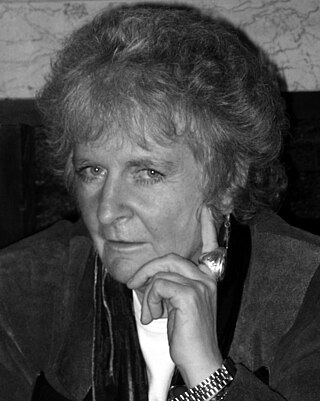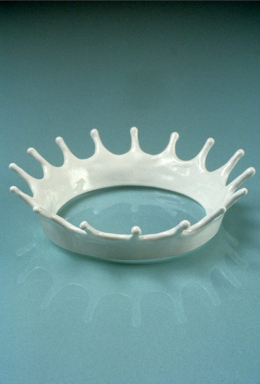Related Research Articles

Sea urchins or urchins are typically spiny, globular animals, echinoderms in the class Echinoidea. About 950 species live on the seabed, inhabiting all oceans and depth zones from the intertidal to 5,000 metres. Their tests are round and spiny, typically from 3 to 10 cm across. Sea urchins move slowly, crawling with their tube feet, and sometimes pushing themselves with their spines. They feed primarily on algae but also eat slow-moving or sessile animals. Their predators include sea otters, starfish, wolf eels, and triggerfish.

Margaret J. Hambling is a British artist. Though principally a painter her best-known public works are the sculptures A Conversation with Oscar Wilde and A Sculpture for Mary Wollstonecraft in London, and the 4-metre-high steel Scallop on Aldeburgh beach. All three works have attracted controversy.

Beverly Buchanan was an African-American artist whose works include painting, sculpture, video, and land art. Buchanan is noted for her exploration of Southern vernacular architecture through her art.
Wangechi Mutu is a Kenyan American visual artist, known primarily for her painting, sculpture, film, and performance work. Born in Kenya, Mutu now splits her time between her studio there in Nairobi and her studio in Brooklyn, New York, where she has lived and worked for over 20 years. Mutu's work has directed the female body as subject through collage painting, immersive installation, and live and video performance while exploring questions of self-image, gender constructs, cultural trauma, and environmental destruction and notions of beauty and power.
Art intervention is an interaction with a previously existing artwork, audience, venue/space or situation. It is in the category of conceptual art and is commonly a form of performance art. It is associated with Letterist International, Situationist International, Viennese Actionists, the Dada movement and Neo-Dadaists. More latterly, intervention art has delivered Guerrilla art, street art plus the Stuckists have made extensive use of it to affect perceptions of artworks they oppose and as a protest against existing interventions.

Jennifer Bartlett was an American artist and novelist. She was best known for paintings and prints that combine the system-based aesthetic of conceptual art with the painterly approach of Neo-Expressionism. Many of her pieces were executed on small, square, enamel-coated steel plates that are combined in grid formations to create very large works.

Nnenna Okore is an Australian-born Nigerian artist who lives and works in Chicago at North Park University, Chicago. Her largely abstract sculptural forms are inspired by richly textured forms and colours within the natural environment. Okore's work frequently uses flotsam or discarded objects to create intricate sculptures and installations through repetitive and labor-intensive processes. She learnt some of her intricate methods, including weaving, sewing, rolling, twisting and dyeing, by watching local Nigerians perform daily domestic tasks. In her more recent works, Okore uses plant-based materials to create large bioplastic art forms and installations. Her work has been shown in galleries and museums within and outside of the United States. She has won several international awards, including a Fulbright Scholar Award in 2012. and the Australian Creative Victoria Award in 2021.

Heterocentrotus mamillatus, commonly known as the slate pencil urchin, red slate pencil urchin, or red pencil urchin, is a species of tropical sea urchin from the Indo-Pacific region.

Eve is an outdoor sculpture of the biblical Eve created by Robert William Davidson in 1931. It is currently located in a fountain at Ball Nurses' Sunken Garden and Convalescent Park on the campus of Indiana University-Purdue University Indianapolis (IUPUI). The overall dimensions of this bronze sculpture are 5’ tall, 2’ long, and 1’ wide.

Alice Boner was a Swiss painter and sculptor, art historian, and an Indologist.

Vandalism of art is intentional damage of an artwork. The object, usually exhibited in public, becomes damaged as a result of the act, and remains in place right after the act. This may distinguish it from art destruction and iconoclasm, where it may be wholly destroyed and removed, and art theft, or looting.
Above and Below is an installation by American artist Maya Lin, the designer of the Vietnam Veterans Memorial in Washington, D.C. It is on display at and owned by the Indianapolis Museum of Art located in Indianapolis, Indiana, United States. The artwork was inspired by underground water systems in Indiana.
Lila Katzen, born Lila Pell, was an American sculptor of fluid, large-scale metal abstractions.

Annette Lemieux is an American artist who emerged in the early 1980s along with the "picture theory" artists. Lemieux brought to the studio a discipline equally based on introspection, and the manifestations of an ideological minimalism. Process is a key component in the execution of her works over the past three decades, creating the lure to the confrontation of issues of social and historical urgency. Lemieux has been the recipient of awards from the National Endowment of the Arts and the Keiser Wilhelm Museum, Germany and an honorary Doctorate in Fine Arts from Montserrat College of Art. Presently, in addition to her studio and exhibition schedule, she is a senior lecturer at Harvard University in the area of visual and environmental studies.

Jennifer Bolande is an American postconceptual artist. Her art explores affinities and shifts of meaning among sets of objects and images across different contexts and media including sculpture, photography, film and installation. She emerged in the early 1980s with work that expanded on ideas and strategies rooted in conceptualism, Pop, Arte Povera and the so-called Pictures Generation. Her work focuses on thresholds, liminal and peripheral spaces, and transitional moments—states she enacts by the repetition, accumulation and recontextualization of found materials. She frequently selects cultural artifacts on the verge of obsolescence or in flux—and thus acquiring new meanings—and archives, studies and reframes them. Artforum critic Paula Marincola wrote, "Bolande's highly individualized amalgam of sculpture and photography proceeds obliquely but precisely toward an accumulation of possible meanings. She is a connoisseur of unlikely but evocative details, of subliminally perceived, fragmentary images and events."
Steinunn Þórarinsdóttir is an Icelandic sculptor. Her work uses androgynous human figures such as those in her most notable exhibits Borders and Horizons.

Arlene Shechet is an American sculptor known for her inventive, gravity-defying arrangements and experimental use of diverse materials. Critics describe her work as both technical and intuitive, hybrid and polymorphous, freely mixing surfaces, finishes, styles and references to create visual paradoxes. Her abstract-figurative forms often function as metaphors for bodily experience and the human condition, touching upon imperfection and uncertainty with humor and pathos. New York Times critic Holland Cotter wrote that her career "has encompassed both more or less traditional ceramic pots and wildly experimental abstract forms: amoebalike, intestinal, spiky, sexual, historically referential and often displayed on fantastically inventive pedestals … this is some of the most imaginative American sculpture of the past 20 years."
Phoebe ColeGordon was an American artist.
Allison Schulnik is an American painter, sculptor and animated filmmaker. She is known for her heavily textured, impasto oil paintings and her animated short videos. Schulnik is married to fellow artist Eric Yahnker. They live and work in Sky Valley, California.

Heide Fasnacht is a New York City-based artist who works in sculpture, drawing, painting and installation art. Her work explores states of flux, instability and transformation caused by human action and natural events. Since the mid-1990s, she has been known for sculptures and drawings that recreate momentary phenomena such as sneezes, geysers and demolitions—in sometimes abstract or cartoony form—that are temporally and spatially "frozen" for consideration of their aesthetic, perceptual, social or sensate qualities. In the late 2010s, she has expanded these themes in paintings that examine lost and neglected childhood sites, such as playgrounds and amusement parks. ARTnews critic Ken Shulman has described her work as "chart[ing] the fluid dialogue between second and third dimensions, motion and inertia, creation and ruin."
References
- ↑ "Sea urchins, by Jennifer Maestre". ABC News (Australia) . January 16, 2007.
- ↑ Ginger Gregg Duggan, Judith Hoos Fox (2005). Over + Over: Passion for Process. Krannert Art Museum, University of Illinois. p. 46. ISBN 1-883015-36-7.
- ↑ Maestre, Jennifer. "Artist Statement". jennifermaestre.com. Jennifer Maestre. Retrieved 1 April 2017.
- ↑ Fernandes, Andrea (October 24, 2008). "Sculpting With Pencils: Jennifer Maestre". Mental Floss. Archived from the original on 27 March 2017. Retrieved 26 March 2017.
- ↑ "Dangerously Beautiful: The Art of Jennifer Maestre". New Britain Museum of American Art. February 25, 2010.
- ↑ Matt, M. "Amazing Pencil Sculptures by Jennifer Maestre". Big Statue. Big Statues. Retrieved 26 March 2017.
- ↑ "Pencil Sculptures by Jennifer Maestre". Table of Malcontents. Wired. December 8, 2006.
- ↑ "12 Cool Colored-Pencil Sculptures". Woman's Day . January 26, 2010. Archived from the original on July 29, 2010.